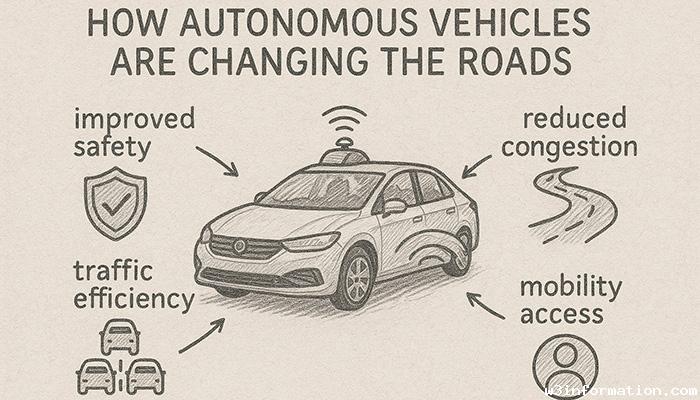How Autonomous Vehicles are Changing the Roads
Self-driving cars which function autonomously continue to revolutionize transportation concepts. The streets now witness science fiction becoming reality while transforming travel safety and infrastructure fundamentally. Self-driving vehicles utilize artificial intelligence and machine learning along with LiDAR and radar sensors to operate with minimal human input.
Enhancing Road Safety
Autonomous vehicles offer major safety advantages because they can limit the number of accidents caused by human mistakes. Self-driving cars strive to enhance road safety by maintaining continuous environmental awareness and immediate hazard response capabilities while eliminating driver distractions and fatigue. With technological advancements experts foresee a major reduction in traffic-related injuries and fatalities.

Revolutionizing Traffic Flow and Congestion:
Communication between autonomous vehicles and traffic systems enables smoother traffic flow and greater transportation efficiency.Drivers would spend less time stuck in traffic while their vehicles would consume less fuel and release fewer emissions which benefits both the traveling public and the planet.Self-driving cars optimize speed management and minimize braking while adjusting their paths dynamically to steer clear of congested roads.
Redefining Car Ownership and Mobility
Self-driving vehicle technology is transforming people's perspectives about owning cars. The change in transportation dynamics will enable improved access to and lower costs for travel particularly in urban environments. The development of autonomous fleets by ride-sharing services such as Uber and Lyft creates opportunities for people to depend on shared transport services instead of possessing personal vehicles.
Transforming Urban Planning and Infrastructure:
The reduction in parking requirements and traffic accidents let urban planners redesign city spaces. The width of roads can be reduced to create additional space for pedestrians and cyclists while new transportation hubs develop. Infrastructure development will progress to accommodate vehicle-to-infrastructure communication capabilities, dedicated autonomous vehicle lanes, and intelligent traffic control systems.
Challenges and Considerations
The potential of autonomous vehicles exists alongside multiple challenges they must overcome. Debates continue over ethical problems including decisions autonomous vehicles must make in unavoidable crash situations. The development of regulations and public acceptance requires policymakers and industry leaders to proceed with careful navigation because these areas evolve at a slow pace.Connected vehicles face significant cybersecurity threats because hackers could potentially compromise their systems.
Conclusion
Autonomous vehicles signify a tremendous technological achievement while simultaneously driving fundamental changes in transportation methods and urban planning. Intelligent vehicles which become embedded in everyday life will transform road systems while reshaping transportation's future. Despite outstanding challenges the significant advantages for safety and accessibility together with operational efficiency support fast-paced development advancement.
 How to Balance School and Extracurricular Activities
How to Balance School and Extracurricular Activities
 Ways to Stay Motivated Throughout Your Academic Journey
Ways to Stay Motivated Throughout Your Academic Journey
 How to Prepare for College Admissions: A Complete Guide
How to Prepare for College Admissions: A Complete Guide
 The Benefits of Learning a Second Language
The Benefits of Learning a Second Language
 Why Emotional Intelligence Should Be Taught in Schools
Why Emotional Intelligence Should Be Taught in Schools
 The Future of Higher Education: Trends to Watch
The Future of Higher Education: Trends to Watch